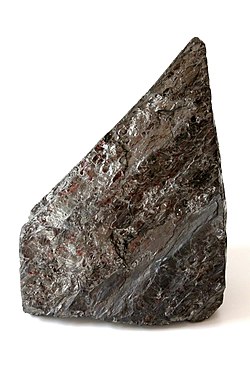Culm (coal)
| Metamorphic rock | |

Anthracite coal
|
|
| Composition | |
|---|---|
| Carbon, 92.1‒98% |
Anthracite is a hard, compact variety of coal that has a submetallic luster. It has the highest carbon content, the fewest impurities, and the highest calorific content of all types of coal except for graphite.
Anthracite is the most metamorphosed type of coal (but still represents low-grade metamorphism), in which the carbon content is between 92.1% and 98%. The term is applied to those varieties of coal which do not give off tarry or other hydrocarbon vapours when heated below their point of ignition. Anthracite ignites with difficulty and burns with a short, blue, and smokeless flame.
Anthracite is categorized into standard grade, which is used mainly in power generation, and high grade (HG) and ultra high grade (UHG), the principal uses of which are in the metallurgy sector. Anthracite accounts for about 1% of global coal reserves, and is mined in only a few countries around the world. China accounts for the majority of global production; other producers are Russia, Ukraine, North Korea, South Africa, Vietnam, the UK, Australia, Canada and the US. Total production in 2010 was 670 million tons.
Anthracite derives from the Greek anthrakítēs (ἀνθρακίτης), literally "coal-like". Other terms which refer to anthracite are black coal, hard coal, stone coal,dark coal, coffee coal, blind coal (in Scotland),Kilkenny coal (in Ireland),crow coal or craw coal, and black diamond. "Blue Coal" is the term for a once-popular and trademarked brand of anthracite, mined by the Glen Alden Coal Company in Pennsylvania, and sprayed with a blue dye at the mine before shipping to its northeastern U.S. markets to distinguish it from its competitors.
Culm has different meanings in British and American English.
...
Wikipedia
